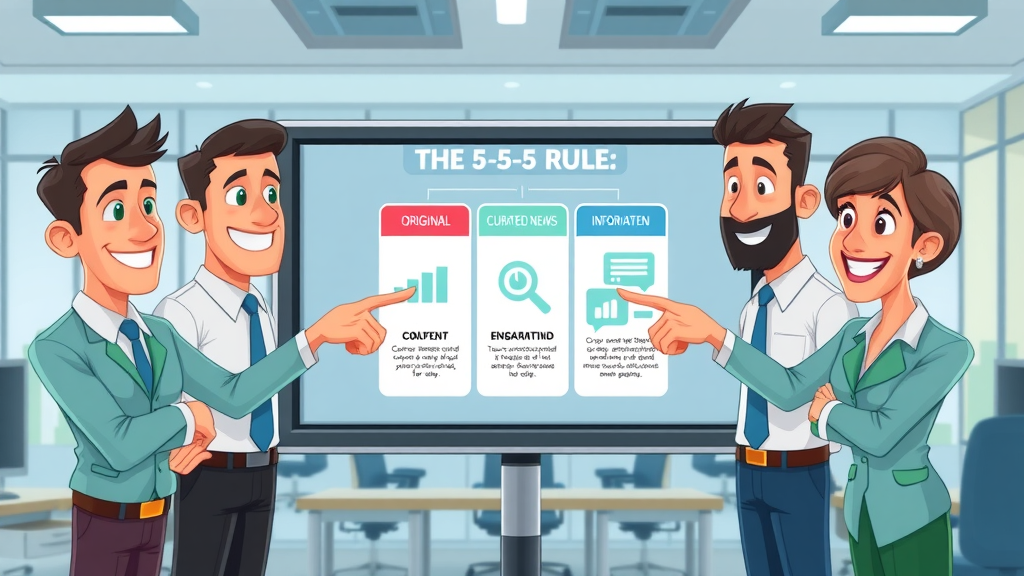Did you know that 73% of local service businesses are outpacing their competition by integrating social media & email marketing? In today's digital-first world, blending these powerful channels isn't just a trend—it's the secret weapon for hyperlocal brand growth and client retention. Whether you run a boutique salon, a family-owned repair shop, or a growing consultancy, mastering these strategies could propel your business ahead. Curious how? Read on for transformative insights!
Unlocking Local Success: Why Social Media & Email Marketing Matters

-
Discover why 73% of local service businesses are outpacing their competition with robust social media & email marketing integration.
-
Learn how these combined digital strategies can elevate your brand awareness and client loyalty.
For local service businesses, social media & email marketing are more than just buzzwords—they are the cornerstone of modern client engagement. The integration of both channels creates multiple touchpoints, nurturing potential clients from awareness to loyalty. A well-executed social media post quickly gets your brand in front of your community, while a targeted email campaign delivers personalized offers directly to your customers' inboxes. Combining efforts maximizes your visibility, fosters trust, and opens up constant opportunities to convert social media followers into loyal clients.
Practical examples abound: a local plumber who shares DIY maintenance tips on Instagram, then follows up with monthly emails offering discount codes; a fitness studio running Facebook events and delivering class reminders via email. When these approaches work in unison, you’re not just marketing—you’re building relationships that lead to repeat business and word-of-mouth referrals. Your marketing efforts become highly targeted, efficient, and community-driven, setting you apart from competitors relying on traditional channels alone.
What You'll Gain from Mastering Social Media & Email Marketing
-
How to align your marketing campaign for maximum community reach
-
Strategy for balancing social media and email to boost conversion rate
-
Proven tactics for building a quality email list through social media marketing
By mastering social media & email marketing , you’ll position your business for explosive local growth. You’ll learn to create marketing campaigns that precisely reach your neighbors, showcase your expertise, and build long-term brand awareness. Equally important, you'll gain the tools to nurture relationships—turning casual browsers into engaged email subscribers and repeat customers. Strategic alignment across these channels ensures you never miss a chance to delight your audience or amplify word-of-mouth referrals.
You'll also unlock measured, data-driven improvements. Understand which social posts drive the most sign-ups, or which email campaign brings clients back for a second service. As your list of engaged subscribers grows, your marketing channel becomes an owned asset—more reliable than unpredictable platform algorithms. Best of all, effective integration allows you to stretch your marketing budget further, often achieving greater ROI than any single channel alone.
To further refine your approach, consider how seasonal trends and timely promotions can supercharge your integrated campaigns. Leveraging seasonal promotional marketing strategies can help you align your social media and email efforts with what matters most to your local audience, ensuring your offers and content always feel relevant and timely.
Decoding the Fundamentals: What is Social Media & Email Marketing?

Defining Social Media Marketing for Local Service Providers
Social media marketing consists of using platforms like Facebook, Instagram, and LinkedIn to connect with your target audience—your neighbors, regulars, and potential clients. By sharing relevant content, tips, behind-the-scenes looks, and customer testimonials, local service businesses can boost brand awareness, foster interaction, and even generate immediate inquiries. Unlike traditional advertising, social media marketing thrives on authenticity and two-way conversation, allowing you to humanize your business and become a fixture in your community's digital landscape.
The effectiveness of this channel depends on consistency and strategic planning. Engaging your audience with a mix of educational, entertaining, and promotional posts ensures your brand stays top-of-mind. For example, a hair salon might showcase transformations, haircare tips, and share delightful behind-the-scenes clips—sparking conversations and growing local followers. Ultimately, social media platforms serve as powerful megaphones for spreading your message wider and faster than ever before.
Essentials of Email Marketing in a Service-Based Business
Email marketing is the practice of sending targeted, personalized messages straight into your client's inbox. For local service businesses, this could mean monthly newsletters, appointment reminders, special offers, or loyalty rewards. Unlike social posts, emails reach a curated list of people who have shown genuine interest in your product or service .
A robust email list enables direct, private communication—uninfluenced by ever-changing platform algorithms. With tools to segment, automate, and personalize, you can create specific email campaigns that cater to repeat customers, first-time visitors, or those who haven't returned in a while. The open rates on emails are often higher than organic social post reach, and a single, well-crafted email campaign can drive serious upticks in bookings or inquiries.
Synergizing Social Media and Email: The Modern Approach
To truly thrive, local businesses must blend social media & email marketing into a unified digital strategy. Sharing opt-in incentives on your social media post can speed up email list growth, while email newsletters can direct subscribers to your latest social campaign or online event. This reciprocal relationship ensures your messaging reaches broader and deeper into your community—multiplying touchpoints and reinforcing your brand's presence both publically and privately.
Modern marketing tools make this synergy seamless. Built-in integrations allow you to track which email subscribers come from Facebook or which Instagram posts generate the most clicks on your special offer. By closely monitoring these interactions, you can fine-tune campaigns for optimal conversion rates , ensuring every marketing effort works harder—together.
Key Rules & Metrics: Navigating Social Media & Email Marketing Strategies
The 5 5 5 Rule on Social Media: What You Need to Know

The 5 5 5 rule is a practical structure for creating content variety and boosting engagement. It suggests that, daily or weekly, you post 5 pieces of original content (such as tips or updates about your business), 5 curated industry insights or news items, and engage with 5 community members or local influencers. This stimulates reciprocal engagement, shows that your business is both knowledgeable and plugged in, and encourages your audience to interact and share your content.
Using the 5 5 5 rule keeps your social media channels lively and balanced. It prevents over-promoting your product or service , avoiding audience fatigue and building authentic connections. Over time, this approach fosters a thriving digital community around your business, driving both visible and word-of-mouth growth across your chosen media platforms .
The 50 30 20 Rule for Social Media: A Balanced Content Mix
Another key to local service success is the 50 30 20 rule . This popular guideline divides your social media marketing content into three segments: 50% valuable industry or community information, 30% personal brand stories or customer testimonials, and 20% promotional content or strong calls to action.
Balanced content mixes humanize your presence and make your brand relatable. By leading with value and human interest, you encourage followers to interact with your brand more often—creating natural opportunities to guide them from social to email subscriber status. This structure also ensures your media and email marketing messages are always relevant and never feel "spammy."
Understanding the Worth of an Email List for Your Business
Building a quality email list is one of the most valuable assets for any local business. Unlike rented audiences on social media platforms , your email list is an owned channel—meaning you control the relationship from start to finish. Industry studies estimate a 1,000-person email list can be worth between £100-£1000 per month, depending on engagement, conversion rates, and the generosity of your offers.
With every name and email address, you're giving yourself ongoing, direct access to nurture leads and drive repeat business. Segmenting your list allows highly targeted email campaigns based on preferences, purchase history, or event attendance. In a digital marketing environment where algorithms often restrict reach, growing your email subscriber base guarantees a reliable pipeline for promotions, education, and community engagement.
Developing Your Social Media & Email Marketing Strategy
Crafting Localized Marketing Campaigns Combining Social Media & Email

Creating effective localized marketing campaigns is crucial for community engagement. Begin by identifying your target neighborhoods and core audience personas. Use social media tools to run polls or ask for feedback, and combine the results with insights from your email subscriber list about client interests or service needs. Tailor your messaging for each campaign—perhaps a “Local Champion Spotlight” series shared on both platforms, followed by a special email offer for community members.
Leverage seasonal trends, local events, or community milestones to make your media and email marketing efforts more relevant. Offer time-limited promotions exclusive to local residents, or announce service launches in your email newsletter first—with early access links posted on your social media . This type of integrated approach amplifies your brand visibility and fosters deeper trust within your client base.
Boosting Brand Awareness Through Multi-Channel Marketing
Multi-channel marketing is essential for raising brand awareness in an era of fragmented consumer attention. By coordinating your messages across both email marketing and social media marketing , you reinforce your brand's voice and keep your business top-of-mind. Sync promotions: Share details on Instagram, then send reminder emails to your most engaged subscribers. Or encourage followers to subscribe to your email list for bonus content or insider deals.
Success is measured by seeing familiar names—who first liked your Facebook page—showing up for appointments booked through your latest email campaign . With each touchpoint, you multiply opportunities for meaningful interaction and referral generation, ensuring your marketing efforts are always working in the background for your growth.
Integrating Landing Pages into Your Email and Social Promotions
A customized landing page can make your marketing campaign far more effective. Create pages optimized for each promotion—whether you're offering a free guide or discount—to capture email subscribers from your social media posts . Use eye-catching visuals, clear calls-to-action, and simple forms. Analyze which channels bring the most sign-ups, then adjust your campaign for even better conversion rates .
It’s just as important to link your email campaign back to your social media platform : encourage newsletter readers to join local groups or share the landing page with their friends. This two-way integration strengthens trust, builds your fanbase, and makes tracking ROI far easier.
"A successful marketing strategy doesn't just reach more people--it inspires conversations that turn into loyal customers."
Building and Growing Your Email List with Social Media Marketing
Tactics to Grow an Authentic Email Subscriber Base

To grow a genuinely engaged email list , offer value with every sign-up and promote opt-in opportunities across your social media accounts. Consider exclusive perks—like early access to events, special discounts, or free resources—that incentivize people to subscribe. Feature attention-grabbing sign-up buttons on your Instagram stories, Facebook pages, and even in business profile bios.
Run regular campaigns to remind followers of these benefits and showcase testimonials from happy email subscribers who’ve enjoyed unique bonuses. Remember: authenticity matters. Engaged email subscribers are more likely to become loyal customers, provided they sense real value and trust from your business right from the start.
Converting Social Followers into Engaged Email Subscribers
Moving your social media followers further down the funnel starts with consistency and trust. Share behind-the-scenes content and micro-promotions, then invite followers to subscribe to your email list for exclusive insights or “insider” deals unavailable to the public. Use stories, teasers, countdowns, or even Facebook/Instagram Live to build suspense around your signup incentives.
Consider collaborating with other local businesses for joint giveaways or “community spotlights,” where entry requires an email opt-in. These campaigns not only increase email list size but deepen your local business network, further strengthening word-of-mouth marketing in your neighbourhood.
|
|
|
|
Comparison of Top Strategies: Incentivized Opt-Ins vs. Social Media Contests |
|
Strategy |
Pros |
Cons |
Best For |
|---|---|---|---|
|
Incentivized Opt-Ins |
Attracts quality, interested leads; builds higher trust and loyalty over time |
Lower, slower initial volume compared to contests |
Long-term list building and loyalty |
|
Social Media Contests |
Rapid list growth; high engagement, strengthens social visibility |
Subscribers may be less targeted; risk of list churn post-contest |
Short-term promotions and buzz creation |
Executing Successful Social Media and Email Campaigns
Creating High-Conversion Email Campaigns for Service Businesses
For high-conversion email campaigns , clarity and relevance are key. Start with personalized subject lines, attention-grabbing preheaders, and a clear, compelling offer. Segment your email subscribers by interest or location to deliver the right message, at the right time—such as appointment reminders, local event invites, or seasonal discounts. Incorporate strong visuals and a singular, action-driven call-to-action that drives readers to your landing page or booking portal.
Analyze your open rates, click-throughs, and responses to identify which offers and formats resonate most with your audience. Continuously refine your approach, and consider A/B testing elements (like call-to-action buttons and images) to boost performance and conversion rate. The more tailored your approach, the higher your ROI from every email campaign .
Planning Marketing Campaigns That Drive Client Action
When planning marketing campaigns across both channels, map out the customer's journey—from seeing your social media post to receiving your email offer and making a booking. Create campaign calendars that align promotions with client needs and local events. Launch your offer on both media and email , but tweak the messaging for each platform to match user intent and expectations.
Incorporate feedback loops by asking for reviews, testimonials, or suggestions following service. Use automated follow-ups via email to capture those ready to book but hesitant, and celebrate every win publicly on social—increasing your perceived demand and credibility within your community.
Optimizing Your Media and Email Marketing Efforts for ROI
Optimization demands constant tracking of your marketing channel performance. Measure key metrics like open rates, click-through rates, conversion rates , and subscriber growth. Invest in user-friendly dashboards or integrated marketing platforms that consolidate data from both social media and email marketing .
Review performance after every campaign, identifying what messaging, timing, or formats drove the best results. Allocate more resources to high-performing channels or content types, and experiment with under-performing segments by testing new approaches or offers. The key is using data to refine and boost your ROI with each round of media and email marketing .
Content Best Practices for Social Media & Email Marketing
Crafting Compelling Social Media Content That Resonates Locally
To connect locally, share content relevant to your neighborhood—spotlighting community members, highlighting local partnerships, or posting about events where your business has a presence. Mix “how-to” quick tips, behind-the-scenes moments, and interactive polls or questions. Use user-generated content, testimonials, and share successes or positive reviews to foster social proof.
Maintain a visually consistent style across your platforms, and use rich images, short videos, or carousels to keep feed engagement high. Never underestimate the impact of authentic stories that show your face, team, or workspace; people buy from those they know and trust—and a local presence makes your business more relatable and memorable.
Structuring Email Content for Higher Open and Click Rates

To boost email open and click rates, focus on personalization and concise copy. Always include the recipient's first name in the subject line or opening salutation, and offer messages that match their interests or recent activities. Use compelling preview text and ensure the main call-to-action appears prominently above the email fold.
Break content into digestible sections, using headers, short paragraphs, and attractive visuals. Drive urgency with limited-time offers or exclusive content available only to your email subscribers . Consistently link to your site or relevant landing pages, and close with a friendly, recognizable sign-off.
Balancing Frequency: When and How Often to Send Email Campaigns
The optimal send frequency for email campaigns depends on your audience and industry, but a safe guideline is once per week or twice per month. Don't overwhelm your subscribers: test different schedules and ask for feedback. Track unsubscription rates alongside open and click rates—if you notice a spike in opt-outs, adjust your cadence and content with more value-driven, less salesy messages.
For maximum engagement, align your most important social media posts and email campaigns around local events, seasonal promotions, or business milestones. Whenever possible, cross-promote: use emails to boost engagement on socials, and vice versa.
-
List of content ideas for engaging different segments of your email and social media audience
Analysing and Optimizing Social Media & Email Marketing Performance
Leveraging Tools to Track Your Marketing Efforts

Robust analytics tools are now standard for effective media and email marketing . Platforms like Mailchimp or Constant Contact integrate with Facebook Ads Manager and Google Analytics, providing a clear view of how your marketing efforts perform across channels. These tools track subscriber growth, open rates, social engagement, and conversions all in one dashboard.
For small businesses, even free tools like Meta Insights and Google Sheets can offer invaluable clarity—showing which marketing channels are driving bookings versus which are best for building brand awareness . The key: check your data at least weekly, not just at the end of the month or quarter.
Measuring Conversion Rate and Other Key Metrics
Assessing conversion rate is vital for optimizing ROI. Calculate the percentage of email subscribers who take your desired action (like booking a service), or social media followers who become leads via your landing page . Other critical metrics include email open and click rates, social post reach, new followers gained, form completions, and campaign-generated revenue.
Use benchmarks from previous campaigns to set realistic goals. Experiment by tweaking only one variable at a time (subject line, image, or send time) for reliable comparisons. Celebrate and amplify your wins; learn and iterate from what doesn’t work.
Adjusting Your Strategies Based on Data Insights
After each campaign, review all analytics and gather direct feedback if possible. Double down on channels or content types that drive the best results, and don’t hesitate to pause or change tactics on under-performing ones. Use A/B testing, audience segmentation, and trend spotting to stay ahead of your competitors.
|
|
|
Table: Essential Metrics for Social Media & Email Campaigns |
|
Metric |
Social Media |
Email Marketing |
|---|---|---|
|
Reach |
Total followers/post views |
Emails sent/opened |
|
Engagement |
Likes/comments/shares |
Link clicks/replies |
|
Conversion Rate |
Clicks to landing page/forms |
Bookings/purchases from email |
|
Growth |
New followers, mentions |
New subscribers |
|
ROI |
Revenue from campaign spend |
Revenue from email costs |
"Marketing without data is like driving with your eyes closed." – Dan Zarrella
The Power of Integrated Marketing Campaigns: Case Studies & Success Stories
Case Study: Local Service Business Triples Bookings with Social Media & Email Marketing

One local landscaping company implemented an integrated marketing strategy by synchronizing social promotions with email reminders. They first used Instagram and Facebook to highlight recent client projects and teased a “spring clean-up” deal. Next, they emailed exclusive early-bird discounts to their email list and invited followers to refer friends for additional savings.
Within two months, their bookings tripled, with 62% of appointments directly traceable to their email and social media marketing efforts. The key to their success? Consistent messaging, cross-channel incentives, and frequent performance reviews—proving the compounding impact of a truly integrated approach.
How a Targeted Email List and Social Media Ads Built Unmatched Brand Awareness
A neighborhood pet care service wanted to dominate their market's brand awareness . They ran hyperlocal Facebook and Instagram ads inviting users to sign up for a newsletter with monthly pet care tips and exclusive coupons. Their email sign-up offer was also featured in their social bios and shared at community events.
In just six months, they grew their email list from 150 to over 1,200 genuinely interested locals. Thanks to regular, value-driven emails and creative posts, their brand became synonymous with expertise and trust in their area—leading to referrals and a loyal base of repeat clients.
FAQs for Social Media & Email Marketing in Local Services
What is social media and email marketing?
-
Social media & email marketing involves leveraging platforms like Facebook, Instagram, LinkedIn, and targeted inbox campaigns to connect, nurture, and convert clients for local service businesses.
What is the 5 5 5 rule on social media?
-
The 5 5 5 rule recommends sharing 5 pieces of your own content, 5 pieces of curated industry news, and engaging with 5 others, daily or weekly.
How much is a 1000 email list worth?
-
A quality 1,000-person email list for local businesses can be valued between £100 and £1000 monthly, depending on industry engagement and direct offers.
What is the 50 30 20 rule for social media?
-
The 50-30-20 rule divides content: 50% industry value, 30% personal brand stories, and 20% calls to action or direct sales posts.
List of Actionable Tips for Social Media & Email Marketing Success
-
Segment your email and social audiences for tailored marketing campaigns
-
Use visuals consistently to increase engagement on both channels
-
Automate follow-up email campaigns to boost conversion rate
-
Encourage online reviews via social media to gain community trust
Key Takeaways: Maximizing Growth with Social Media & Email Marketing
-
Integrating both channels leads to higher brand awareness and business growth
-
Data-driven marketing efforts refine your messaging and boost ROI
Claim Your Local Advantage with Social Media & Email Marketing
-
Take action with 30 days of FREE social media content (£499 value): https://socialprowess.socialmediasite.com/
If you’re ready to take your local service business to the next level, expanding your digital presence beyond social and email is the logical next step. Discover how optimizing your online visibility with local SEO can further amplify your reach and attract even more clients in your area. Explore actionable strategies and expert tips in our guide to boosting local SEO and online visibility —and unlock the full potential of your integrated marketing efforts.
Start integrating your social media & email marketing today—segment, optimize, track, and watch your local business flourish!
Integrating social media and email marketing is essential for local service businesses aiming to enhance brand awareness and client loyalty. By combining these channels, businesses can create multiple touchpoints, nurturing potential clients from initial awareness to long-term loyalty. For instance, a well-crafted social media post can introduce your brand to the community, while a targeted email campaign delivers personalized offers directly to customers’ inboxes. This synergy maximizes visibility, fosters trust, and increases opportunities to convert social media followers into loyal clients.
Practical examples include a local plumber sharing DIY maintenance tips on Instagram and following up with monthly emails offering discount codes, or a fitness studio running Facebook events and sending class reminders via email. When these approaches work in unison, businesses build relationships that lead to repeat business and word-of-mouth referrals. This integrated strategy ensures marketing efforts are highly targeted, efficient, and community-driven, setting businesses apart from competitors relying solely on traditional channels.
By mastering social media and email marketing, local service businesses can create campaigns that precisely reach their neighbours, showcase expertise, and build long-term brand awareness. This approach also provides tools to nurture relationships, turning casual browsers into engaged email subscribers and repeat customers. Strategic alignment across these channels ensures businesses never miss a chance to delight their audience or amplify word-of-mouth referrals.
Additionally, integrating seasonal trends and timely promotions can supercharge campaigns. Leveraging seasonal promotional marketing strategies helps align social media and email efforts with what matters most to the local audience, ensuring offers and content always feel relevant and timely.
To further enhance your understanding and implementation of these strategies, consider exploring the following resources:
-
“Social Media Marketing 101: The Complete Guide for Local Businesses” ( localiq.com )
-
“How to Promote Your Business Through Local Email Marketing” ( blog.hubspot.com )
These guides offer comprehensive insights into optimizing social media and email marketing efforts, providing actionable tips and strategies tailored for local service businesses.
 Add Row
Add Row  Add
Add 


Write A Comment